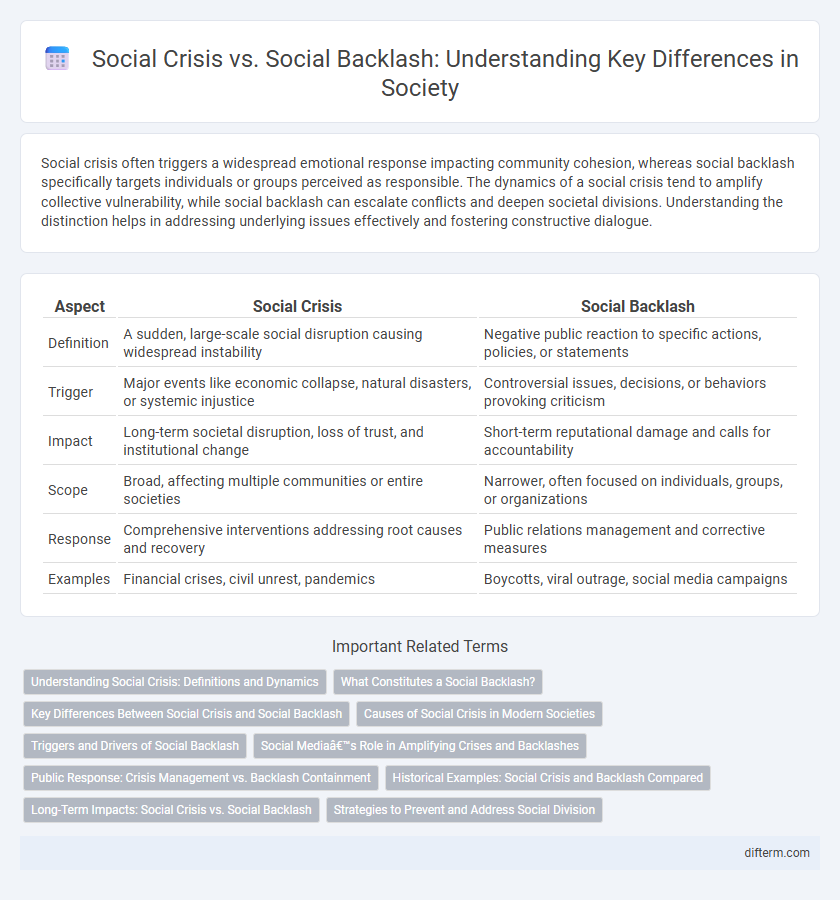Social crisis often triggers a widespread emotional response impacting community cohesion, whereas social backlash specifically targets individuals or groups perceived as responsible. The dynamics of a social crisis tend to amplify collective vulnerability, while social backlash can escalate conflicts and deepen societal divisions. Understanding the distinction helps in addressing underlying issues effectively and fostering constructive dialogue.
Table of Comparison
| Aspect | Social Crisis | Social Backlash |
|---|---|---|
| Definition | A sudden, large-scale social disruption causing widespread instability | Negative public reaction to specific actions, policies, or statements |
| Trigger | Major events like economic collapse, natural disasters, or systemic injustice | Controversial issues, decisions, or behaviors provoking criticism |
| Impact | Long-term societal disruption, loss of trust, and institutional change | Short-term reputational damage and calls for accountability |
| Scope | Broad, affecting multiple communities or entire societies | Narrower, often focused on individuals, groups, or organizations |
| Response | Comprehensive interventions addressing root causes and recovery | Public relations management and corrective measures |
| Examples | Financial crises, civil unrest, pandemics | Boycotts, viral outrage, social media campaigns |
Understanding Social Crisis: Definitions and Dynamics
A social crisis occurs when widespread instability disrupts communities through economic, political, or cultural turmoil, threatening societal cohesion and wellbeing. Social backlash refers to intense negative reactions from a group or society in response to perceived changes or injustices, often resulting in protests or resistance movements. Understanding the dynamics of social crises involves analyzing root causes, stakeholder impacts, and the feedback loops that can amplify social backlash into broader unrest.
What Constitutes a Social Backlash?
A social backlash occurs when a group reacts strongly against perceived social change or progressive movements, often manifesting through protests, public criticism, or campaigns opposing certain policies or cultural shifts. Unlike a social crisis, which involves widespread societal disruption or instability, a social backlash specifically targets actions or ideas viewed as threatening established norms or values. This response can hinder social progress by reinforcing resistance to change within communities or institutions.
Key Differences Between Social Crisis and Social Backlash
Social crisis involves widespread disruption impacting societal stability, often triggered by events like economic collapse or natural disasters, leading to urgent collective responses. Social backlash refers to strong public opposition or negative reactions against specific policies, cultural changes, or social movements, primarily reflecting ideological conflicts. Key differences lie in scale and impact: social crises affect entire communities or nations, demanding structural solutions, while social backlash centers on ideological resistance often expressed through protests or social media campaigns.
Causes of Social Crisis in Modern Societies
Rapid urbanization, economic inequality, and systemic discrimination are primary causes of social crises in modern societies. These factors disrupt social cohesion by fostering resentment and marginalization among disadvantaged groups. Environmental degradation and political instability further exacerbate tensions, leading to widespread unrest and conflict.
Triggers and Drivers of Social Backlash
Social backlash is often triggered by rapid social changes that challenge established norms, provoking fear and resistance among affected groups. Key drivers include misinformation, perceived threats to identity or economic stability, and amplified reactions through social media platforms. These elements combine to escalate conflicts and deepen societal divisions during periods of social crisis.
Social Media’s Role in Amplifying Crises and Backlashes
Social media platforms accelerate the spread of social crises by enabling real-time sharing and widespread visibility, often intensifying public outrage and backlash. Algorithms prioritize emotionally charged content, increasing exposure to divisive narratives and heightening tensions during social conflicts. This amplification effect can transform localized issues into global phenomena, influencing public opinion and policy responses rapidly.
Public Response: Crisis Management vs. Backlash Containment
Public response to a social crisis involves strategic crisis management aimed at mitigating harm and restoring trust through transparent communication and decisive actions. In contrast, social backlash containment focuses on addressing widespread negative reactions by controlling narratives, managing public outrage, and implementing measures to prevent escalation. Effective handling of social crises requires building resilience and fostering dialogue, while backlash containment prioritizes damage control and reputation repair.
Historical Examples: Social Crisis and Backlash Compared
The French Revolution exemplifies a social crisis where systemic inequality led to widespread unrest and the eventual overthrow of the monarchy, while the backlash manifested in the Reign of Terror, characterized by political purges and societal repression. Similarly, the Civil Rights Movement in the United States triggered a social crisis by challenging institutionalized segregation, provoking a backlash marked by violent resistance and the rise of segregationist policies. These historical examples reveal how social crises often ignite transformative change but also provoke significant backlash that attempts to restore previous power structures.
Long-Term Impacts: Social Crisis vs. Social Backlash
Social crises often lead to prolonged economic instability, increased inequality, and erosion of public trust that can persist for decades, severely impacting community resilience. Social backlash, while sometimes intense, typically triggers policy reforms and shifts in social norms that can mitigate long-term damage by addressing underlying grievances. Understanding the distinct long-term impacts is crucial for developing strategies that promote recovery and social cohesion.
Strategies to Prevent and Address Social Division
Effective strategies to prevent and address social division include promoting inclusive dialogue that values diverse perspectives, implementing community-based conflict resolution programs, and fostering education initiatives that emphasize empathy and social cohesion. Leveraging technology to facilitate transparent communication and monitoring social media for early signs of unrest can also mitigate potential crises. Policymakers and community leaders must collaborate to build trust through equitable resource distribution and responsive governance, reducing the risk of social backlash.
social crisis vs social backlash Infographic

 difterm.com
difterm.com